Some interesting insights into evolving discovery and consumption habits.
* This article was originally published here
Make money online fast using proven strategies, courses and trainings. Best recommended product reviews, affiliate marketing tips and resources.
Some interesting insights into evolving discovery and consumption habits.
It could be worth tuning in, especially as we head into the holiday push.
Today, every professional needs to be comfortable on camera. From Zoom interviews to in-house marketing videos to 1-1 sales outreach videos — the post-pandemic worker must thrive in a digital-first world.
In the years since the pandemic, the relevance and power of videos in sales and marketing — or what we call “The Visual Sale”— remains strong.
So much so, that video is now a requisite for many customers. According to HubSpot, More than nine out of 10 people report wanting to see more videos from brands.
We’ve heard it for years, but now more than ever, the cliché is true: Adding video content into your marketing and sales process isn't just a "nice to have;” it’s a must have.
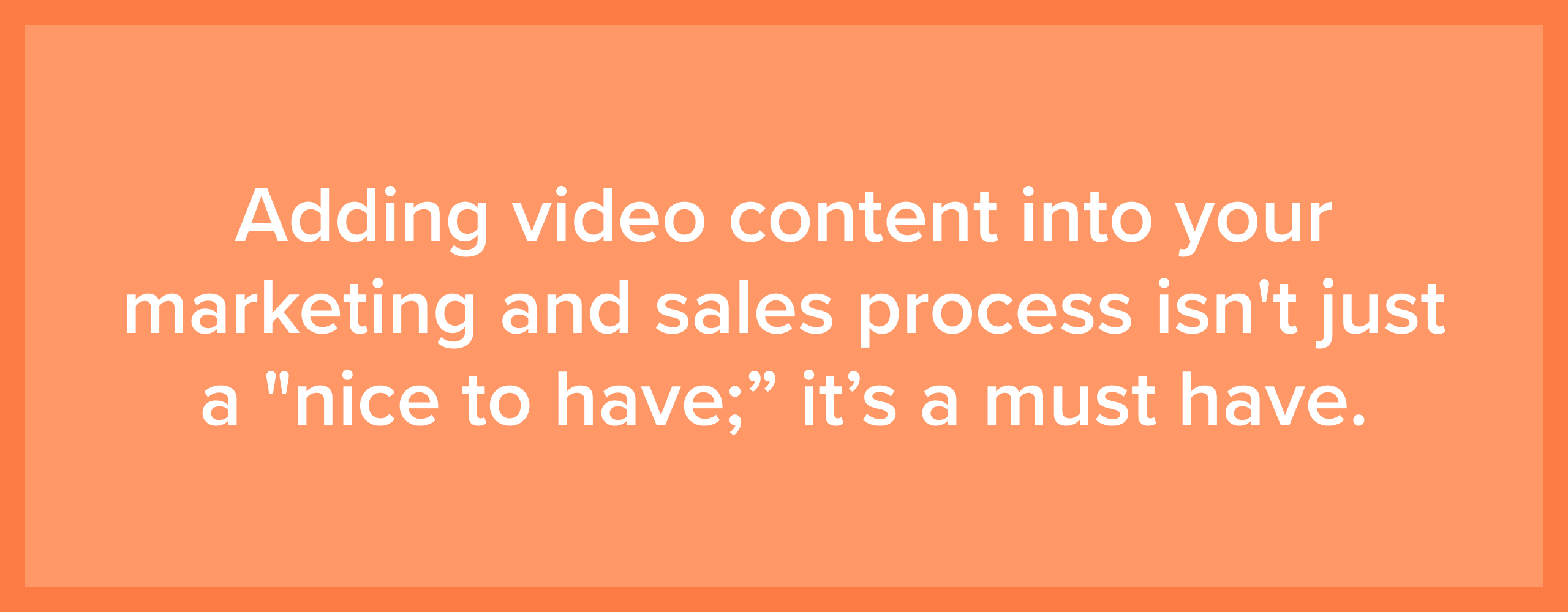
Even so, some business leaders are wary about the price tag that comes along with video production. But professional video doesn’t have to — and often shouldn’t — be an expensive financial endeavor, especially when it comes to sales.
Rest assured, you can look and sound great on video without breaking the bank, and below, we'll explain how.
And just to note, we made some recommendations below. These are not paid endorsements, just our personal favorites.
For many high-quality marketing videos, you'll likely need a DSLR camera, which can cost thousands of dollars. But you can make sales videos right from your laptop. We recommend adding a 4K webcam, but these can be as little as $35.
This should be all you need (at least, camera-wise) to produce great video.
When you begin filming, you’ll quickly realize that bad lighting can make you end up with a “hostage” video.
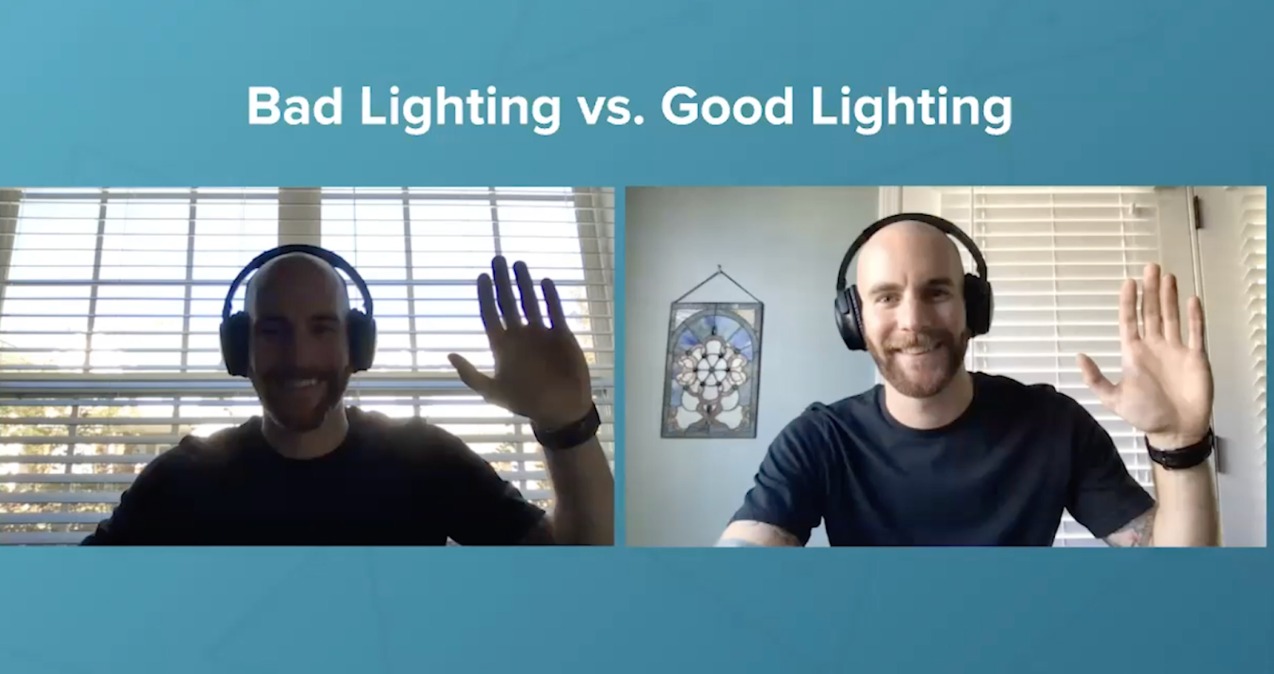
In every sale video, you'll want to come off as positive, approachable, and inviting. Not only do you need to entice people to click and keep watching, but you also want to make sure they are paying attention to your message.
Bright, natural light helps accomplish this by making it easier for a viewer to see your subject’s face and expressions. Lighting also creates an airy, positive ambiance. Dark or poor lighting, on the other hand, can have the opposite effect.
For great lighting on a limited budget, aim to have a natural light source across from your face (for example, a window or lamp behind the camera).
However, you may also want to invest in some small equipment, such as a ring light or a three-point lighting kit to provide fill light and avoid harsh shadows. Many online retailers sell inexpensive lighting kits to help those making professional videos get set up with great lighting in a few seconds.
(For ring lights, check out this one from Amazon for $21.)

Want to avoid glare on your glasses? Try softening the lighting with tissue paper or an umbrella. More on that here.
Like lighting, poor audio quality can distract viewers from actually paying attention to your message.
High-quality videos have sound quality that is crisp, clear, and free of background noise. If you’ve ever watched any of your own videos recorded from your phone or webcam, you’ve probably noticed that the audio quality was lacking.
To help improve your audio and video quality overall, use headphones with a built-in microphone, or consider using pillows and blankets to help with echoes. These techniques or noise-canceling through your headphones will also help muffle any distractions so you can focus.
A USB-powered mic is a quick fix that's easy to set up. At IMPACT, a lot of us use the Blue Yeti, which costs about $100. But there are many cheaper options as well.

Or, you may also consider investing in an external recorder or lav mic that can be clipped to your shirt. This sound will be recorded separately from your raw footage, but it will also be more crisp and clear.
On the software side, you'll need a place to record your videos. You could use Vidyard or Loom, which both come with free versions. Or you could use a native application on your computer like Quicktime.
Krisp.ai is a great app that can help cut out background noise (and is very popular among our team).
More than likely in your sales video, you should be the focus. You want to make sure that you project camera presence every time you make a video. With this in mind, try to keep your camera at about waist or chest height. This a the right height to create the impression of an intimate conversation, but still allow for people to see your hand gestures and body language.
(Note: This is also the prime set-up for personalized 1-1 videos sent in email or during the sales process.)
Small tools like a laptop stand or tripod can help accomplish this, but you can also consider simply placing your camera on top of a stack of books or sitting on pillows to raise yourself up as one team member did in this example.
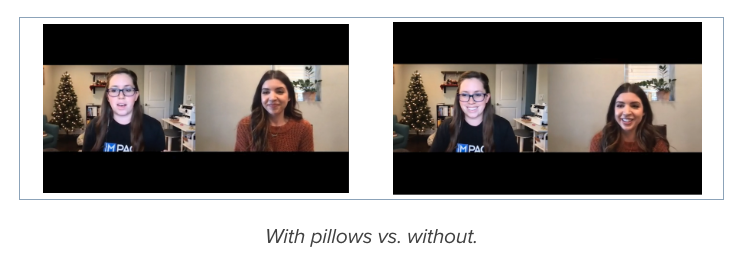
You’ll also want to place yourself in the center of the frame, unless you’re presenting content on the screen simultaneously.

Regardless of the option you choose, make sure your laptop or mobile device is level and steady. Shaky footage can be as distracting as poor audio or video quality.
Like lighting and audio quality, your background can either enhance or detract from the message of your sales videos. Again, you want the viewer to be focused on you and what you are saying, not distracted by the pile of clothing on your bed or the bright red cereal box on top of your refrigerator. (All very real possibilities if your home is your office.)
A good rule of thumb in any situation is to pick a simple, clean background. Try using a plain wall or something uniform like a bookcase or area with framed photos. You can also hang a sheet behind you or buy an inexpensive backdrop.
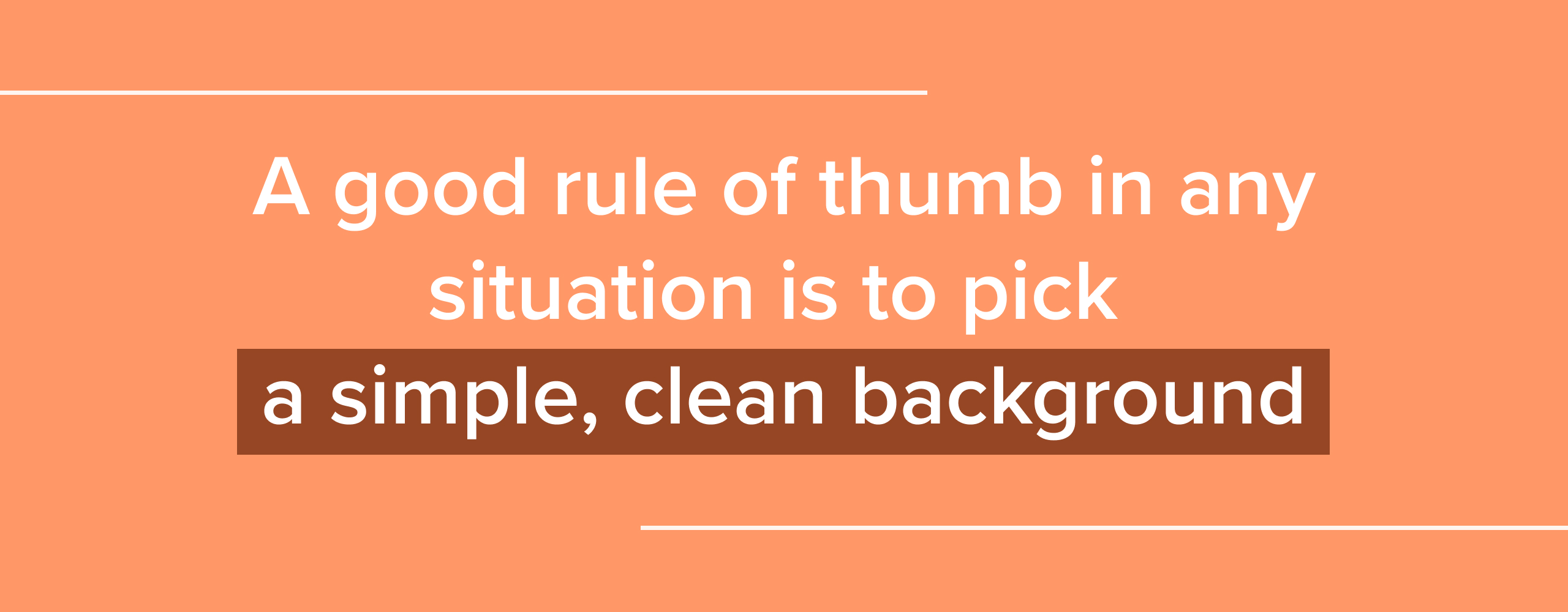
Simple backgrounds are also the easiest to light, helping ensure that you produce professional looking videos without having to fuss too much.
Have key talking points you need to cover in your video? While you don’t want to look or sound like you’re reading off a script in a professional video, it’s good to have notes handy to keep track of what you need to say. Great videos flow naturally, but that doesn’t mean the speaker was flying off the cuff or memorized their points.
Try having a Google Doc open with bullet points of your topics or simply writing them out on a sticky note that you stick on your camera or laptop so they can’t be missed. Video tools such as Vidyard also have built-in note functions so you aren’t fumbling with multiple windows or tools.
(And even if you do fumble, don’t worry. When you’re finished recording, that can usually be fixed with the help of simple video editing programs.)
After filming, post-production is where you perfect your videos. For personalized 1-1 videos, this likely won’t come into play frequently, but should you like to have one on hand, the gold standard is Adobe Premiere Pro, but there are a number of cheaper tools.
AI-powered platforms like Descript and Vidyo.ai make it extremely easy to make quick edits, even if you're a video novice.
To dive more into the options and how to choose the right video editing software for you, check out this full list of our favorites.
And if you're ready for expert advice on how to get past your biggest sales obstacles, talk to a sales coach at IMPACT. We help businesses like yours every day.
You know your company should be doing more video. You’ve known it for years. But now, as many of the old roadblocks get removed, you’ve got fewer excuses than ever before.
With each passing year, video gets quicker to film, easier to share, and cheaper to produce.
AI tools for video promise to take away even more barriers to entry, but you can go too far. A tool may offer efficiency — but that same tool could end up doing more harm to your brand than good.
When you enter the realm of synthetic media — that is, deceptive or overly manipulated video, you could potentially destroy the very trust you’re setting out to build with video.
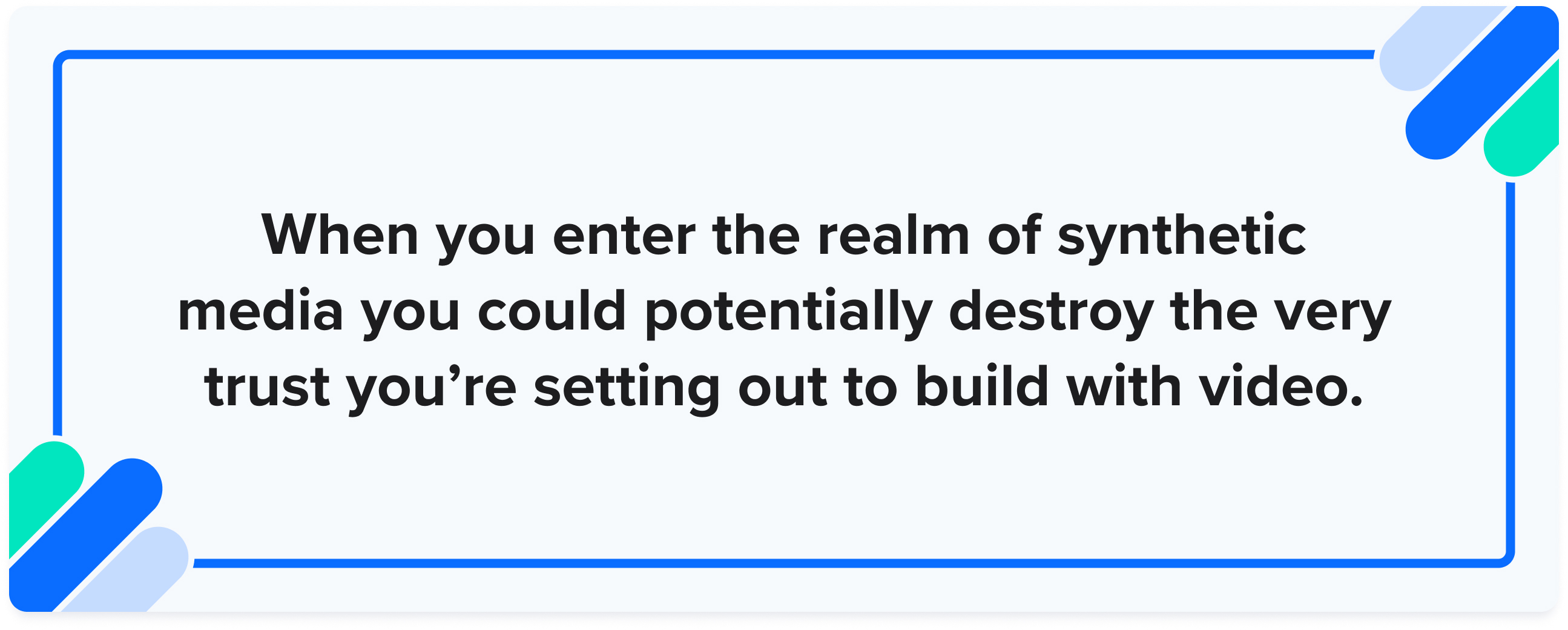
Marcus Sheridan, author of They Ask, You Answer and The Visual Sale believes AI will level the playfield by allowing scrappy companies to outpace the big boys. At the same time, he sees the danger of taking AI shortcuts that undermine the integrity of your brand.
In all things, he says, you need to keep your core principles in mind: Your content exists to help your buyers. AI can multiply those efforts and get content out the door quicker — but you should avoid tools that will diminish your trustworthiness in the marketplace.
Demand for video is at an all-time high. And it’s not coming back down. YouTube is the second most popular website in the world (behind only its parent company Google), with more than 2.7 billion active users in 2023. And, according to Wyzowl, 91% of internet users want to see more video from brands.
If your business is late to the party producing video content, you’re missing out on a way to connect with a huge audience.
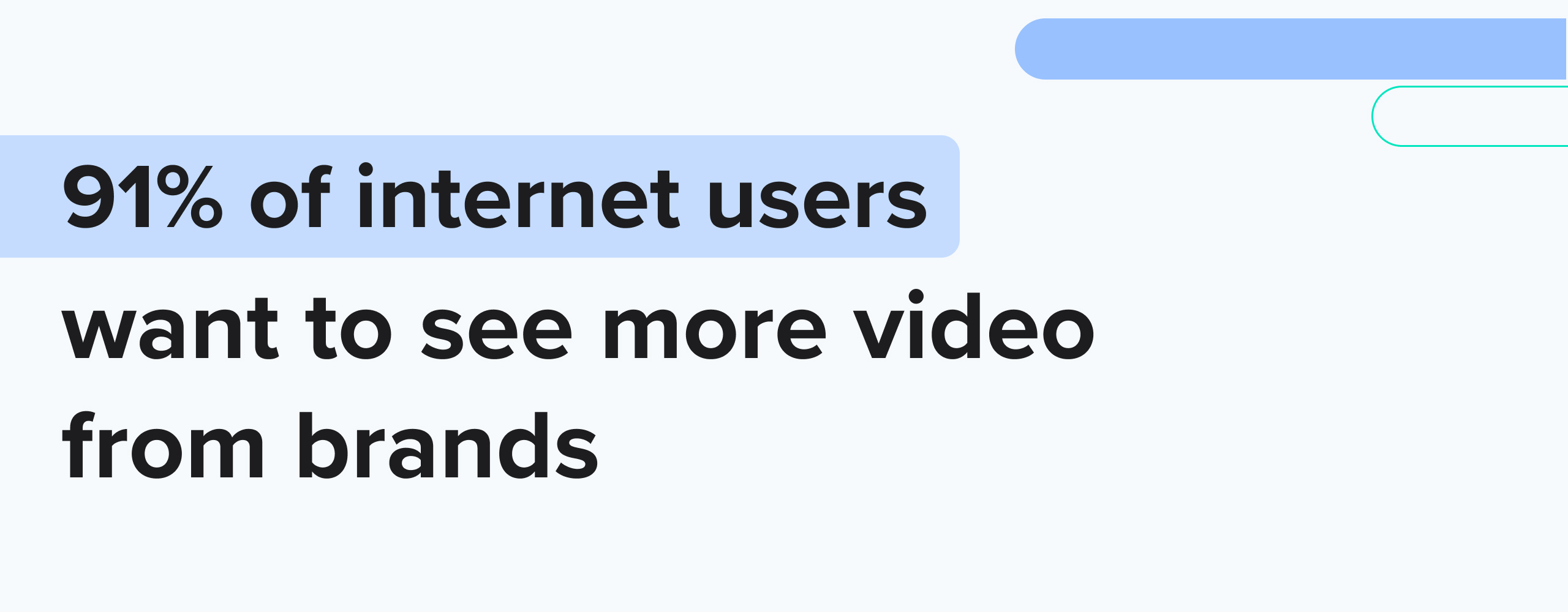
But video isn’t just a box you can check. You need to be making videos for the right reasons. According to Marcus, video is so powerful because it allows your potential customers to get to know you and your brand before they ever reach out to your sales team.
When you make videos that answer buyers’ questions, you build trust with your audience and create a brand people want to follow.
With or without AI, this should be the principle behind any video content you create.
Today, with voice cloning technology, you can make someone say something they never said. Add in deepfake technology and you can make a convincing visual to go along with it.
Should audio cloning and deepfakes be a part of your marketing?
For Marcus, the line of delineation is intent. If your goal is to be helpful, you’re likely on the right track. If you’re seeking to be deceptive, you’re not. A video created with malicious purposes (or without the expressed consent of the person in the video) has no place in the marketing of your company.
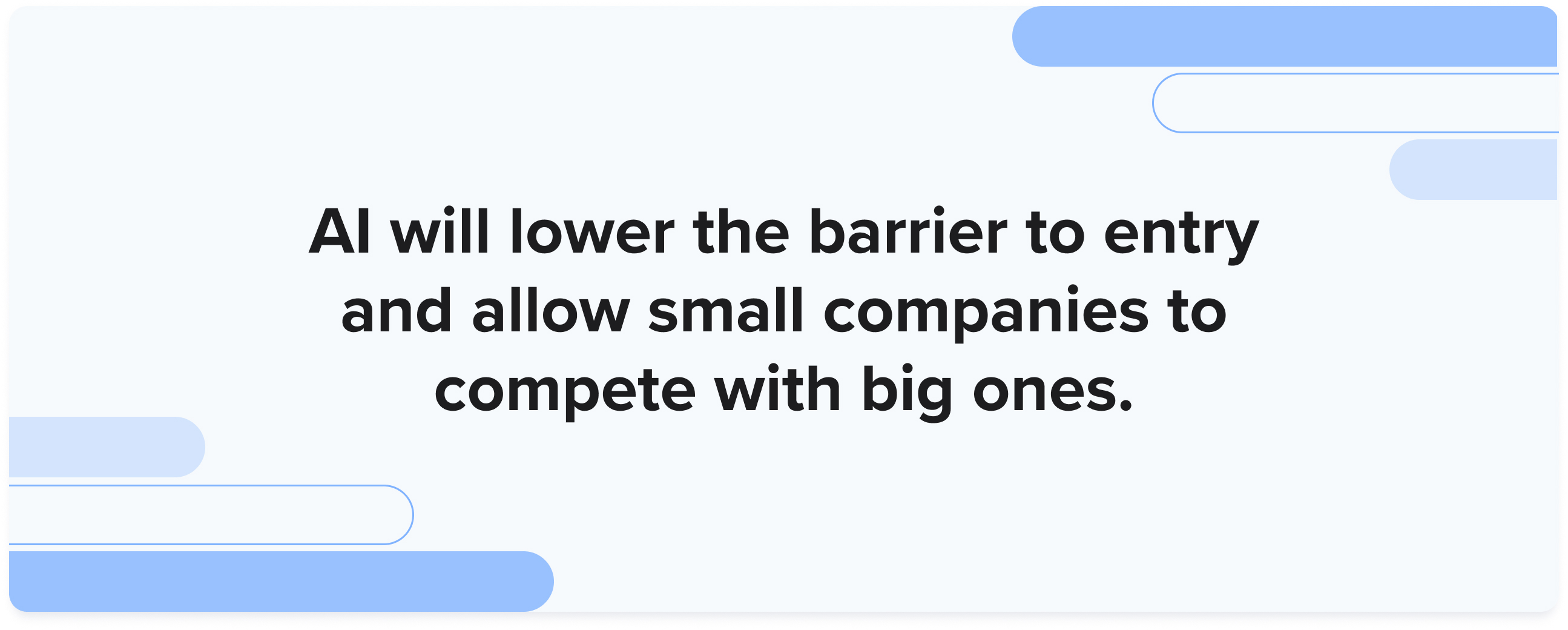
But these technologies themselves are not the problem. They are tools — and could be used for good or ill, depending on who wields them.
Say you film a video of a colleague and a few lines get flubbed. With that person’s permission, there’s no problem using voice cloning to fill them in.
Other applications will depend on your brand, your team, and the technology.
If you need to make a video of a team member, but that person lives across the country, should you deepfake it? What about filling in one missing shot with a deepfake?
For Marcus, as long as you’re not being purposefully deceitful or misleading, you can (and should) use the technology to make better content.
With a few clicks, you can create a digital avatar to be the spokesperson for your brand: That is, a fictional digital “person” that can look and sound the way you want. This “person” could host your videos, walk a new hire through onboarding, or facilitate internal training. Look at this example from Sythesia.
It’s fast. You can import a document, pick a persona, and have a video done in a matter of minutes.
Marcus is okay with this, provided it’s made clear to the audience. However, he advises companies that the power of video is that your buyers can see you, hear you, and get to know you before they ever pick up a phone or fill out a form.
If you’ve created the right video content, the building blocks of trust should be present before someone enters into a sales conversation.
Your actual people might not be as polished as a computer-generated avatar, but they are the real people your buyers will be working with, and, according to Marcus, you should show them whenever possible.
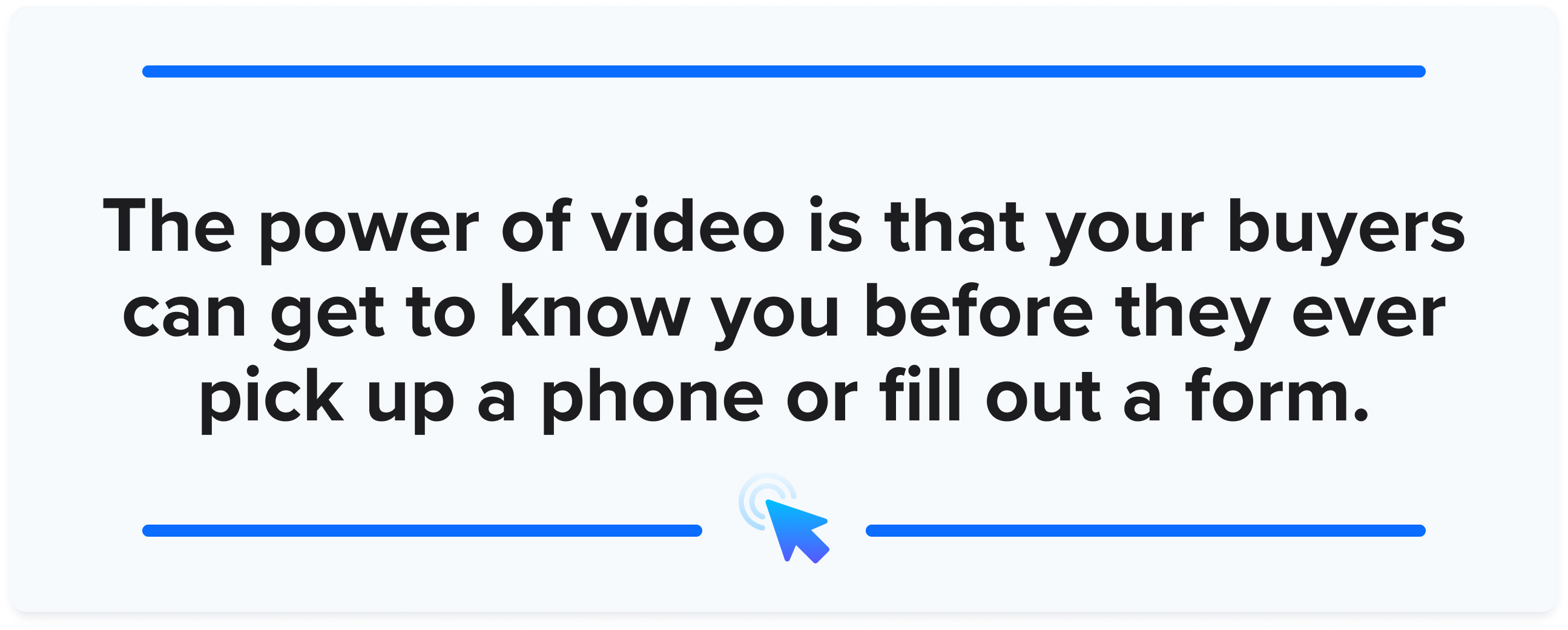
But, imagine an avatar of Marcus himself that’s trained on his books and speeches. It could answer questions from clients the exact way Marcus would — but at scale.
Marcus has no problem with such technology, provided he knows about it and has signed off. But he admits this brings up interesting questions. For one, what would happen if the real employee were to leave the company? Do contracts today have any clauses about digital likeness?
In a landscape where authenticity is on everyone’s mind, Marcus advises companies to let people peek behind the scenes.
For years, videographers operated with the exact opposite approach to what your math teachers used to demand. In algebra, you were always supposed to show your work. For videographers, what was left on the cutting room floor was never to see daylight.
Until now.
According to Marcus, a way to bring authenticity to your content is to offer viewers a glimpse into your process.
Show what goes on in pre-production, show your outtakes. In doing so, you’ll show your personality and prove your authenticity.
Marcus believes that AI will do what the internet did a generation before: lower the barrier to entry and allow small companies to compete with big ones.
Suddenly, you don’t need a full video production team to turn out great content. You can be more agile, more creative, and more efficient than the big boys who, despite all their resources, can’t get out of their own way.
But those new abilities come with a warning. Don’t get yourself onto a slippery slope where you’re sacrificing the authenticity of your brand in the name of speed.
Use the tools, but be sure to keep humans in the process and stay true to your principles.
X is set to release its new calling options soon.
This year, 90% of global advertisers increased their investment in short-form video content. And that’s no surprise to me, a video trainer who works on the front lines with clients. Short-form video is everywhere. Of course, it’s on Instagram and TikTok, but short-form video is also on LinkedIn — and it’s heavily promoted on YouTube.
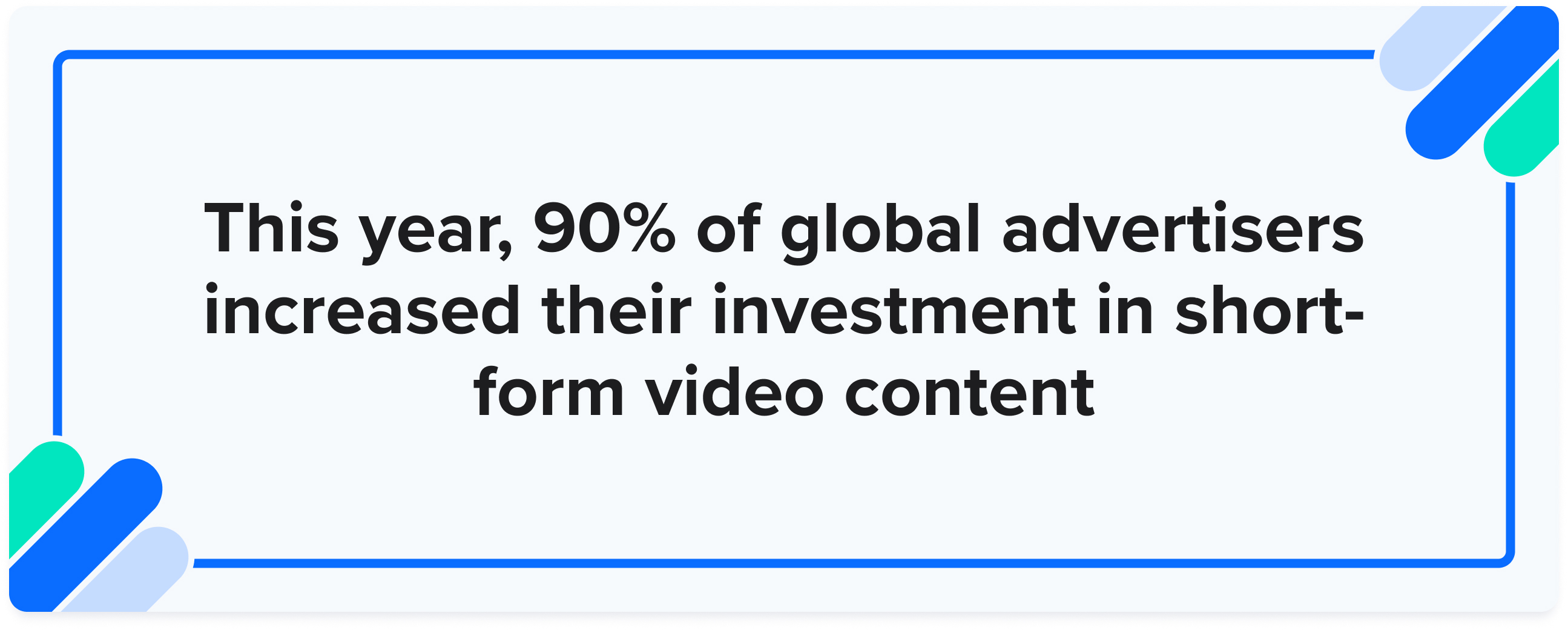
In short, wherever your audience hangs out online, they’re consuming short-form video. Which makes it an essential part of any modern marketing strategy.
To learn more about what it is and why you need it — as well as tips for getting started — keep reading.
As the name suggests, short-form videos are, well, short. They may be as long as a minute, or even 90 seconds, but are usually 30 seconds or less. Some are as short as 10 seconds.
These videos are vertically-oriented (think: shot on a phone), and often play on a loop (or auto-play into the next one, suiting short audience attention spans.
Following in the popular footsteps of TikTok, platforms are prioritizing these kinds of videos, which boosts their reach. Instagram leaned into Reels, while YouTube did the same with Shorts.
Earlier this year, HubSpot found most marketers reported short-form video having the best ROI compared to all other media formats.
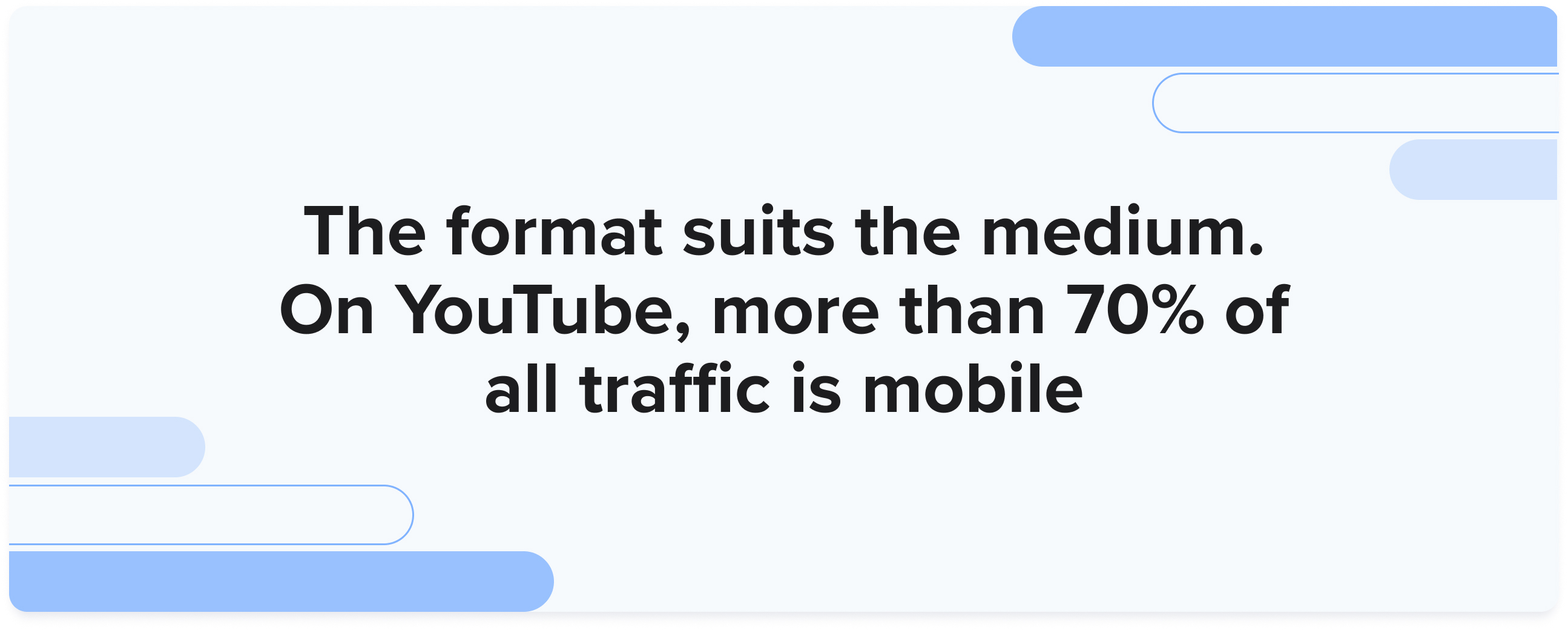
And it makes sense. The format suits the medium. On YouTube, more than 70% of all traffic is mobile, so it makes sense that the contact would be prioritized to the device.
Let me ask you this: Have you ever been scrolling on social media and come across a product you never knew existed — maybe even one that solved a problem you didn’t know you had — and bought it right away?
Yeah, me too. Social platforms know a ton about you, from brands you follow to posts you’ve liked, and they serve up content that fits your profile.
When you’re on social media, you’re in a very different mindset than when you’re using a search engine. If you’re typing a question into Google, you have some idea of what you’re looking for. You have some need that’s brought you there.
When you’re on social media, you’re in a different headspace. You’re there to scroll through and see what you find. Pictures of your sister’s vacation, weird political posts from that friend you haven’t talked to since high school, you know, that kind of thing. You’re in a mindset to discover.
Some marketers call social media sites discovery platforms.
Because short-form video lives on discovery platforms, you have a chance of reaching people who are not even in the awareness stage of the buyer’s journey yet.
They’re pre-awareness.
And this is a goldmine.

By the time someone enters the awareness stage, they’ve already started to narrow down their options. If they google best chiropractors near me, for instance, they’ve already decided that a chiropractor (not, say, a massage therapist or an acupuncturist) is what they need.
Discovery platforms let you connect with a huge audience of potential buyers BEFORE they decide what their problem is.
Short-form videos are typically less produced than other types of video. This means the expected threshold for quality is lower, which means less scripting and less editing.
You should still be doing your best work, but think of these like as crafting a social media post as opposed to a blog article. Shorter, quicker, snappier, more consumable.
A few things to keep in mind:
As you experiment with short-form content, don’t lose sight of why you’re making video content in the first place: to educate (and possibly entertain) your audience. While you can be playful and funny, you should always strive to be authentic.
.jpg?width=2590&height=1040&name=why-short-form-videos-are-vital-tool-for-reaching-your-audience-04%20(1).jpg)
Make videos that build trust with your brand.
Not sure how to do that? Show your people. Show your process. Show what makes you unique. If you’re a manufacturer, a 30-second video of your facility might seem commonplace to you, but it could be fascinating to your audience. If you’re an electrician, make a quick video of you upgrading an electrical panel.
If you’re not sure which videos your audience is looking for, come and talk to us. We help businesses just like yours build trust — and build their brand — through video content.
Where does each social platform rank in terms of active users? Here's a look at the latest data.
Instagram chief Adam Mosseri says that the Threads team is working to drive more engagement.
X owner Elon Musk flagged the pending removal of Circles back in May.
These will bring back some memories of trends past.
AI’s impact on traditional search and SEO is twofold. First off, ChatGPT makes it easier than ever to create content, which means that we’re flooding an already saturated space with more and more written content, much of which is almost identical to everything else out there.
While this is new, the idea of content saturation is not.
The other big change is new, and AI-powered generative search could upend search as we know it.
Generative search is different from a traditional search engine. Rather than returning links to ads and pages, it generates an answer to your question, summarizing based on the data it can access and has been trained on.
Traditional search engines crawl the internet and use algorithms to serve up links (and snippets) to the best content related to keywords in the search query.
While that’s pretty common knowledge, we have to admit the obvious here. We don’t really know exactly how search engines work. For decades, there’s been a lot of conjecture, estimation, hearsay, and rumor about search engine optimization — some from experts and some from charlatans.
We know even less about how AI works.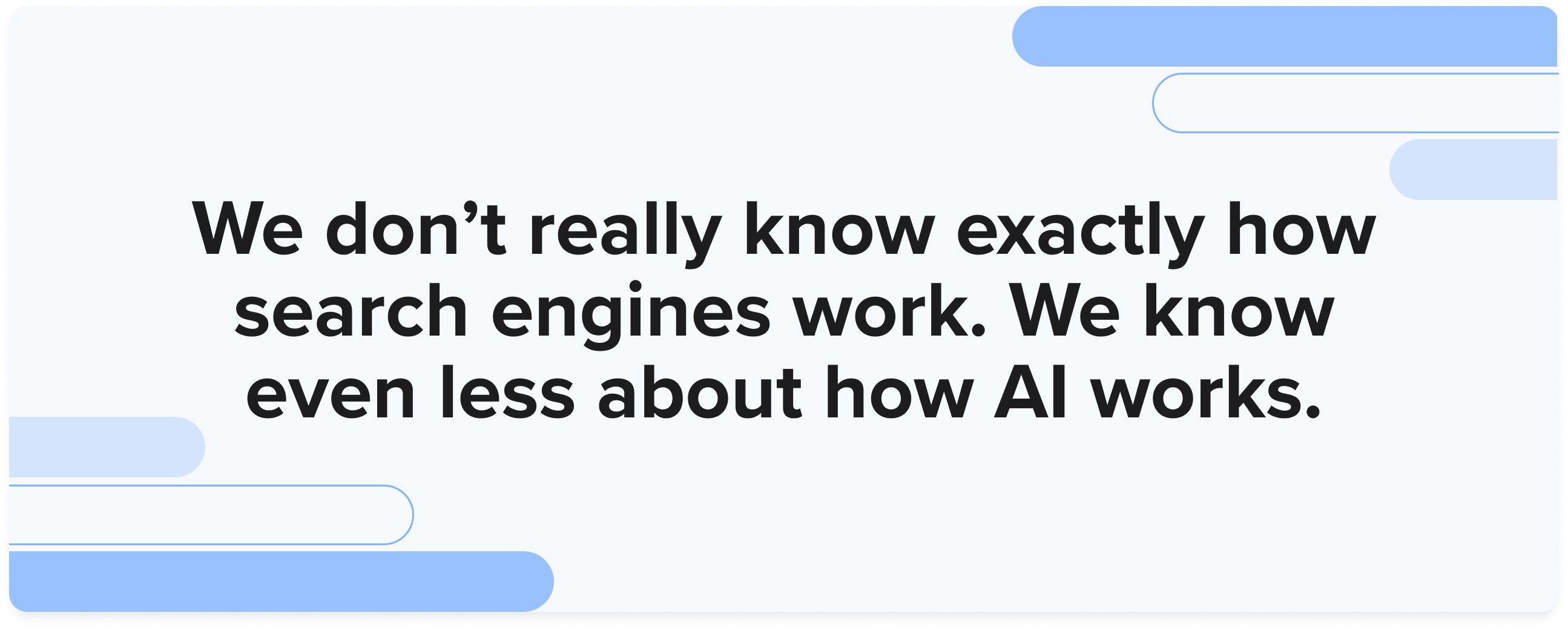
In simple terms, generative search is an information resource that provides a unique response to every user question. These are powered by large language models that use advanced computing to predict the most useful answer to a given question.
But we don’t know exactly how a tool like ChatGPT evaluates Source 1 compared to Source 2 compared to Source 23,691.
We also don’t know how generative search results will incorporate paid content or links to source material. And these are huge questions.
Even so, this is not a time to just hope and pray that the LLMs find our websites. Here's my advice for marketers and strategists out there.
At this point, we don’t really know how generative search finds and serves answers. Heck, even top AI scientists don’t totally understand how it works.
Considering this playing field, you should remember why you’re producing content in the first place.
If you’re producing content that’s fluffy, clickbaity, or too self-promotional, Google has been trying to diminish your returns for years — and it’s likely generative search won’t promote your brand either.
The true goal of content is to educate your audience about what you sell. This means producing content that builds trust with would-be buyers so they can make an informed purchase.
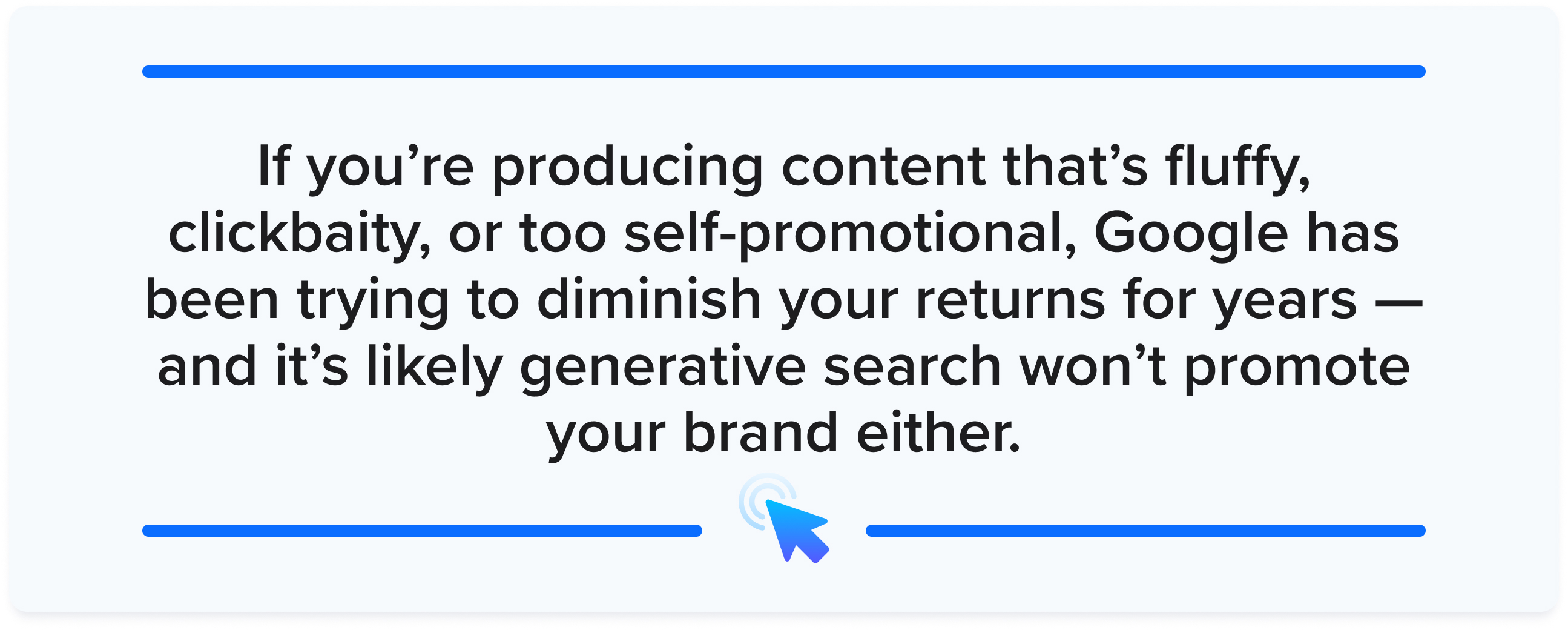
Early indicators show that generative search tools are serving up trusted and respected sources (government sites and studies, reputable news outlets). As the technology expands and it serves up more and more answers about your industry, the most trusted voices in your space are the ones that will win out.
In the early days of content marketing, analytics were simple. Traffic turned into leads, leads turned into sales. With form fills and cookie tracking, you could trace a visitor’s journey across your site and into your sales pipeline. You could choose an attribution model to prove how much your content was helping your bottom line.
A marketing trainer recently told me that for her clients, less than half of all contacts have opted in to cookie tracking. At the same time, we’ve come to understand that buying journeys are anything but linear. ![]()
With marketing analytics more complex than ever before, how do we track an audience using generative search or chatbots?
I advise my clients to stitch together the full picture from a variety of sources.
Reviewing data in different platforms, such as Google Analytics 4, Google Search Console, HubSpot (or your marketing tool of choice), SEMRush, and other tools to help gauge differences and nuances in the data.
This can help you better understand the full picture that’s happening, for the tools may track metrics differently. This will give you the best visibility into what is happening for your user journey — especially as more and more of these tools add AI elements to help improve efficiencies, recommendations, and performance.
One constant in digital marketing is change. Every few months there are new tools, new algorithm updates, new social platforms, new analytics features, and new research.
The other constant in digital marketing is stability. As the ground shifts beneath our feet, the companies that hold true to their principles are the ones that stay on course. 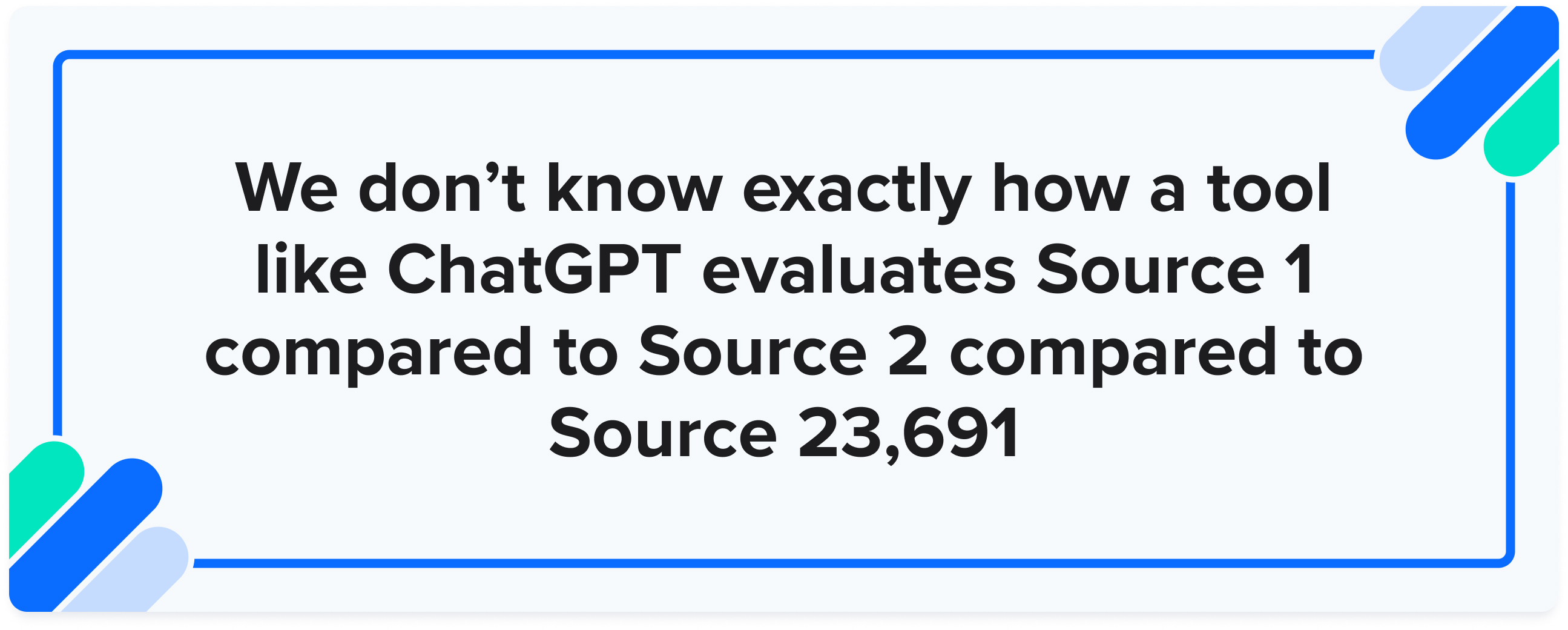
Keep one eye on what’s trending. Read everything you can. Experiment with new tools. Listen to experts.
At the same time, don’t get distracted by the shiny objects. Beware charlatans offering AI expertise that seems flimsy or too good to be true.
Remember why you produce content in the first place: It’s for your customers. Help them understand their problems. Help them understand the marketplace. Help them the way you’d want to be helped if you were in their shoes.
When those are your guiding principles, you’ll rarely find yourself off course.
The new X UI is coming. * This article was originally published here How to make $1000/day with affiliate marketing 24/7 - start here! ...